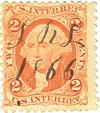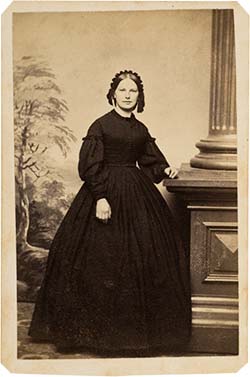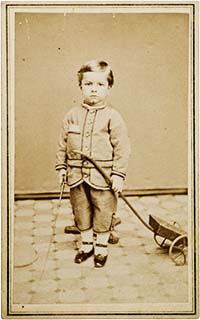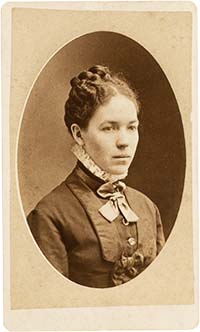Inexpensive Cartes de visite
The carte de visite changed consumer photography as much as the introduction of any other type of photograph. First, the image had a more natural appearance than the black-base of the tintype. And since the materials were cheaper and easier to work with, prices of photographs continued to fall.
However, the CDV (as it has come to be known) process was the first to employ a glass negative. Previous photographs were unique, one-of-a-kind pictures. But now, the consumer could buy several copies of a picture, and share them with friends and relatives. In 1870 an advertisement quoted six CDVs for $1.00.
Assembling a collection of family photographs became a popular tradition. Photograph albums began appearing in the early 1860s, starting a collecting activity that has lasted to the present time.
Is My Image a Carte de Visite?
This is the easiest of early photographs to identify. The image was developed on a very thin sheet of paper, and then was glued to stiff card stock. Carte de visite, or CDV, actually denotes a size or format. Later photographs employed the same process, but have different names to describe their format. For example, early cabinet cards used the exact same process as the CDV, but were just larger.
So, a CDV is a specific size: 2 3/8" x 4 1/4". Note the size may vary up to 1/4", especially with early samples as the photographer may have cut his own card stock. But generally they were close in size, partly due to the standard size of album slots.
Carte de visite Characteristics
| There are several carte de visite features which make dating the
majority of them relatively easy – within a few years. The most
accurate and fortunately the easiest features to identify are listed
here in order of most importance:
|
| |
Card Corners
This is one of the easiest and most dependable dating techniques.
Square corners dominated the cards until 1870. Then rounded corners,
much less susceptible to damage were introduced. Caution: Many
square cards have been rounded through handling and wear. Look for
even, sharp corners to decide if it was round or square. Also, some
cards were hand trimmed by the owner, usually at an angle for easy placement in albums.
|
| |
|
|
|
Image Size
Early camera and lens technology did not produce large, sharp
images. A small picture was much more forgiving. Just as when any
new technology is introduced, all photographers did not replace
their equipment with the latest cameras at once. Therefore, overlap
in dating pictures due to image size can occur. But combined with
other features, this can be very helpful. One concept to keep in
mind: Well-established photographers in large cities are most likely
to be on the leading edge of technology.
|
|
| Image Size: Less than 3/4" . . . . . . .
Image Size: About 1" . . . . . . . . . . .
Image Size: Between 1 1/2" - 1/3/4"
Image Size: Fills Complete Card . . . |
1860-1864
1862-1867
1865-1872
1874-1910 |
|
| |
|
| |
Borders
While a little riskier to use as a definitive dating technique, it is still worthwhile to know the border styles as they evolved, particularly in the later 1860s and early 1870s. The earliest CDVs had no border. In about 1862 a single thin line, sometimes two lines were used to outline the picture area. In 1864 two lines, a thin inner one and a thicker outer line, became popular. In the early 1870s, much thicker lines came into vogue, and then disappeared again later in the decade.
| |
|
|
No Borders . . . . . . . . . . . . . . . . .
.
Two thin lines . . . . . . . . . . . . . . . .
One thin, one thicker line. . . . . . . .
Very Thick Border . . . . . . . . . . . . .
|
|
1860-1862
1862-1863
1864-1869
1874-1880
|
|
| |
|
|
|
Backgrounds
Until the late 1860s the background was either void or consisted of only a chair, small table, or other object which the subject used to steady themselves. Around 1870 decorative backdrops and props were used, sometimes to the point of absurdity. Too many fences, rocks, and other decorations detracted from the phototgraph's subject.
|
| |
|
|
|
CDV Tax Stamps
Tax Revenue Stamps were used to help pay for the Civil War. From August 1864 to August 1866 photographs were taxed, which required that stamps be affixed to the photo. This has become a great way to date Civil War era photos. |
 |
|
|
|
|

A classic 1862 CDV of a Civil War era woman
in a hoop skirt.
Timeline:
- Appeared: 1859
- Peaked: 1863-1877
- Waned: 1877-1882
CDV Characteristics
-
Image on thin paper, mounted on card stock
-
Early cards very thin, became thicker about 1870, and even more about 1880
- Most exhibit the classic sepia tone
Common Size

1864 CDV of boy with pull toy

1879 CDV with oval image typical in the 1870s
See the Gallery of 1,000 Images for a collection of dated CDVs. Click here: Gallery CDVs
|
Get The Detailed Source of Information
The new 19th Century Card Photos KwikGuide
|
Everything you need in a step-by-step guide to help you establish a reliable date of your cartes de visite. Read More
|
 |
|
|
|
|